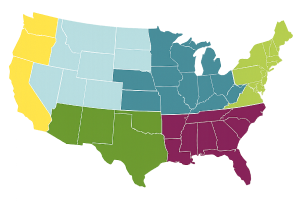
How do we use your location?
Knowing your location helps us recommend plants that will thrive in your climate, based on your Growing Zone.

Knowing your location helps us recommend plants that will thrive in your climate, based on your Growing Zone.
The beautiful and easy-to-grow Japanese Irises: Though theyre sometimes overshadowed by the larger Bearded Irises, many gardeners think the Japanese types are the most beautiful. First, lets dispel the confusion that surrounds this group:
Kaempferi, Butterfly, or Japanese? Even this groups name is confused. Once they were known as Kaempferi Irises, today many call them The Butterfly Irises, but the correct common name is simply Japanese Iris. This group are cultivars of the species Iris ensata, cultivated in Japan for over 500 years, and once restricted to enjoyment by royalty only.
No, theyre not water dwellers. Many people think Japanese Irises are for growing in the water in ponds, but they are not. They require about the same conditions as ferns, astilbes or impatiens--just moist ground, which most all gardeners can easily provide.
The Flowers: As you can see by the photos, these iris blooms are quite different from the tall stand-up flowers of the big Bearded Irises. The standards (the top layer of petals) stand up tall on the Bearded Irises, and the falls (the lower layer of petals) droop elegantly. With Japanese Irises, both sets of petals are more flat, forming a simpler, flatter--and many think more beautiful--flower.
Growing Japanese Irises: Unlike the big bearded iris, which are planted in late summer, Japanese types are usually planted in spring. (They are some of the most popular Beardless irises, along with the Siberians and Louisianas.) They form large lavish clumps and are highly decorative, blooming in late summer. Theyre also great for cutting. They definitely deserve a place in your garden.
As soon as your order is placed you will receive a confirmation email. You will receive a second email the day your order ships telling you how it has been sent. Some perennials are shipped as potted plants, some as perennial roots packed in peat. The ‘Plant Information’ section describes how that item will ship. All perennials and fall-planted bulbs are packaged to withstand shipping and are fully-guaranteed. Please open upon receipt and follow the instructions included.
Perennials and fall-planted bulbs are shipped at the proper planting time for your Growing Zone. Perennial and fall-planted bulb orders will arrive separately from seeds. If your order requires more than one shipment and all items are shipping to the same address, there is no additional shipping charge. See our shipping information page for approximate ship dates and more detailed information. If you have any questions, please call Customer Service at (802) 227-7200 or contact us by email or chat.